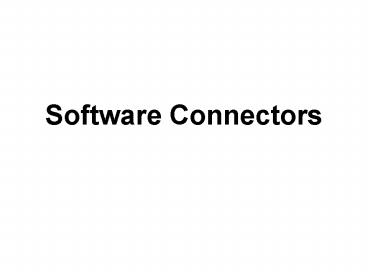Software Connectors - PowerPoint PPT Presentation
1 / 22
Title:
Software Connectors
Description:
Title Author: csews Last modified by: UNIMAP Created Date: 12/3/2002 11:31:56 PM Document presentation format: On-screen Show Company: USC Other titles – PowerPoint PPT presentation
Number of Views:96
Avg rating:3.0/5.0
Title: Software Connectors
1
Software Connectors
2
Role and Challengeof Software Connectors
How do we enablecomponents A and B to interact?
- B
- A
What is the right answer?
3
Connector Foundations
- Manage the flow of control and flow of data
- Every connector has one or more channels, also
known as ducts. - Simple connector provides one type of interaction
service - Combined connector combine many kinds of
interactions
4
Software Connectors
- Architectural element that models
- Interactions among components
- Rules that govern those interactions
- Simple interactions
- Procedure calls
- Shared variable access
- Complex semantically rich interactions
- Client-server protocols
- Database access protocols
- Asynchronous event multicast
- Each connector provides
- Interaction duct(s)
- Transfer of control and/or data
5
Implemented vs. Conceptual Connectors
- Connectors in software system implementations
- Frequently no dedicated code
- Frequently no identity
- Typically do not correspond to compilation units
- Distributed implementation
- Across multiple modules
- Across interaction mechanisms
- Connectors in software architectures
- First-class entities
- Have identity
- Describe all system interaction
- Entitled to their own specifications
abstractions
6
Reasons for Treating Connectors Independently
- Connector ? Component
- Components provide application-specific
functionality - Connectors provide application-independent
interaction mechanisms - Interaction abstraction and/or parameterization
- Specification of complex interactions
- Binary vs. N-ary
- Asymmetric vs. Symmetric
- Interaction protocols
- Localization of interaction definition
- Component independence
- Component interaction flexibility
7
Benefits of First-Class Connectors
- Separate computation from interaction
- Minimize component interdependencies
- Support software evolution
- At component-, connector-, system-level
- Potential for supporting dynamism
- Facilitate heterogeneity
- Become points of distribution
- Aid system analysis testing
8
Software Connector Roles
- Locus of interaction among set of components
- Protocol specification (sometimes implicit) that
defines its properties - Types of interfaces it is able to mediate
- Assurances about interaction properties
- Rules about interaction ordering
- Interaction commitments (e.g., performance)
- Roles
- Communication
- Coordination
- Conversion
- Facilitation
9
Connectors as Communicators
- Main role associated with connectors
- Supports
- Different communication mechanisms
- e.g. procedure call, RPC, shared data access,
message passing - Constraints on communication structure/direction
- e.g. pipes
- Constraints on quality of service
- e.g. persistence
- Separates communication from computation
- May influence non-functional system
characteristics - e.g. performance, scalability, security
10
Connectors as Coordinators
- Determine computation control
- Control delivery of data
- Separates control from computation
- Orthogonal to communication, conversion,
facilitation - Elements of control are in communication,
conversion facilitation
11
Connectors as Converters
- Enable interaction of independently developed,
mismatched components - Mismatches based on interaction
- Type
- Number
- Frequency
- Order
- Examples of converters
- Adaptors
- Wrappers
12
Connectors as Facilitators
- Enable interaction of components intended to
interoperate - Mediate streamline interaction
- Govern access to shared information
- Ensure proper performance profiles
- e.g., load balancing, concurrency control
13
Connector Types
- Procedure call use parameters and return values
- Data access data store components e.g.. MySql
- Event message occurred based on event
- Stream transfer large amt of data between
autonomous processes deliver results - Linkage provide facilitation services during
certain operation - Distributor identify interaction paths
- Arbitrator streamline operation and resolve
conflicts - Adaptor support interaction between components
that are new to each other
14
Procedure Call Connectors
15
Event Connectors
16
Data Access Connectors
17
Linkage Connectors
18
Stream Connectors
19
Arbitrator Connectors
20
Adaptor Connectors
21
Distributor Connectors
22
Discussion
- Connectors allow modeling of arbitrarily complex
interactions - Connector flexibility aids system evolution
- Component addition, removal, replacement,
reconnection, migration - Support for connector interchange is desired
- Aids system evolution
- May not affect system functionality
- Libraries of OTS connector implementations allow
developers to focus on application-specific
issues - Difficulties
- Rigid connectors
- Connector dispersion in implementations
- Key issue
- Performance vs. flexibility































